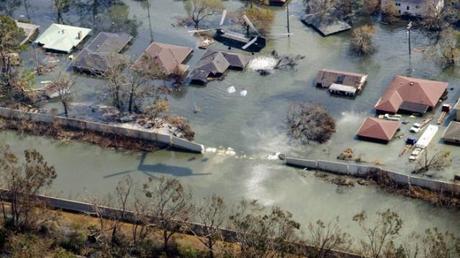By the time Hurricane Katrina made landfall near Buras, Louisiana in the early morning of August 29, 2005, flooding had already started.
At 5 a.m., an hour before the storm hit land, the US Army Corps of Engineers, which administers the levee and levee system in and around New Orleans, received a report that the levees the 17th Street canal, the city's largest drainage canal, had been breached. To the east of the city, massive storm surges sent torrents of water over the levees along the Mississippi River-Gulf Outlet (MRGO) and into the parish of St. Bernard, located just southeast of New Orleans.
In total, levees and walls in and around New Orleans fell in more than 50 locations during Hurricane Katrina, flooding 80% of the city and 95% of St. Bernard Parish.
Although thousands of New Orleans were evacuated in the days leading up to Katrina, approximately 100,000 people remained in the city. The flooding caused power outages and transportation failures throughout the city, making emergency response to the storm even more difficult. In particularly affected areas, like the Lower Ninth Ward, water has reached depths of up to 15 feet, trapping many people in rooftop houses or attics for days before being rescued.
The exact death toll is still uncertain, but it is estimated that more than 1,500 people in Louisiana lost their lives to Hurricane Katrina, many from drowning. The devastation caused by the storm and the accompanying dike failure left millions homeless in New Orleans and along the Gulf Coast, and some 400,000 residents eventually left the city for good. .
WATCH: Cities of the Underworld: Hurricane Katrina on HISTORY VaultTraffic signs
Immediately after Katrina, federal officials - including Michael Brown, director of the Federal Emergency Management Agency (FEMA), who later resigned for handling Katrina's response, and President George W. Bush - claimed that the catastrophic failure of the New Orleans levees was something no one could have predicted. "I don't think anyone anticipated the breakwaters of the dikes," Bush said on September 1, 2005, in an interview with Hello America.
But the sea wall failures were not a complete surprise. For years before Hurricane Katrina, scientists, journalists, and emergency officials worried about what could happen if a major hurricane hit New Orleans.
During Hurricane Georges, a Category 2 storm in 1998, waves on Lake Pontchartrain, north of the city, reached within a foot of the top of the dikes, reported John McQuaid and Mark Schleifstein in the New Orleans Times-Picayune in 2002. "A stronger storm on a slightly different trajectory ... could have achieved the worst-case scenario of emergency officials: hundreds of billions of gallons of lake water pouring over dikes in an area on average 5 feet below sea level with no drainage, "they wrote, three years before Katrina hit.
READ MORE: Hurricane Katrina: 10 facts about the deadly storm and its legacyThe bowl effect
Fears of flooding date back to the founding of New Orleans on land in 1717 by French-Canadian explorer Jean-Baptiste Le Moyne, Sieur de Bienville. Human intervention - including expansion onto drained swamps surrounding the original town - and erosion of coastal wetlands have only made matters worse over the centuries. By the time Katrina arrived, New Orleans was on average six feet below sea level, with some neighborhoods even lower than that.
Surrounded by water - Lake Pontchartrain to the north and the Mississippi River to the south - and bordered by swamps on two sides, New Orleans has long relied on a system of dikes to protect it from flooding. But the city's low elevation, and its position in the various dike systems, creates a so-called "bowl effect", which means that when water enters the city, it is very difficult to drain it. . During Katrina, with many pumping stations damaged by the storm, water remained in the basin.


Jerry Grayson / Helifilms Australia PTY Ltd / Getty Images
Engineering failures
Before Hurricane Katrina, New Orleans had not experienced a major hurricane for 40 years. After Hurricane Betsy flooded the city in 1965, killing dozens of people and causing more than $ 1 billion in damage, Congress authorized the US Army Corps of Engineers to undertake a major overhaul of the protection system. hurricanes in the region. Yet, due to budget cuts and various delays, the project was only 60-90 percent complete by the time Katrina hit, according to a report from the United States Government Accountability Office.
In the aftermath of Hurricane Katrina, the US Army Corps of Engineers claimed the massive storm overwhelmed the levee system, which was designed to protect the area from a Category 3 or lower storm. Yet subsequent investigations revealed that some of the city's dikes were failing even at water levels well below what they were built for.
In June 2006, the Corps released a report of more than 6,000 pages, in which it took at least part of the responsibility for the flooding that occurred during Katrina, admitting that the dikes had failed due to engineering practices. defective and outdated used to build them. Yet debate continued over who was responsible for the disaster: the report also called on local officials for pushing the Corps to build the least effective hurricane protection system, says the report's lead author. later concluded that it was not justified, according to a 2015 report in New York Times.
In the decade after Hurricane Katrina, federal, state, and local governments spent more than $ 20 billion to build 350 miles of new dikes, flood walls, and other structures. The enhanced system is designed to protect New Orleans from storms that would cause a so-called "100-year flood," or flood that has a 1% chance of occurring in any given year.
Even with these huge expenses, experts continue to question whether New Orleans is truly immune from the next big storm.
